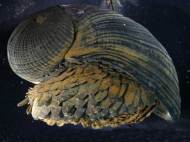Biomimicry of iron-plated snail could lead to better armor
 Tiny snails sitting on the ocean floor might seem defenseless against a large, determined predator such as a crab. But evolution has provided one species of sea snail with a unique iron-plated armored shell that resists such attacks. The snail has evolved a tri-layered shell structure consisting of an outer layer embedded with iron sulfide granules, a thick organic middle layer, and a calcified inner layer.
Tiny snails sitting on the ocean floor might seem defenseless against a large, determined predator such as a crab. But evolution has provided one species of sea snail with a unique iron-plated armored shell that resists such attacks. The snail has evolved a tri-layered shell structure consisting of an outer layer embedded with iron sulfide granules, a thick organic middle layer, and a calcified inner layer.
”By copying aspects of that shell structure, scientists could design better armor for military use”, said Christine Ortiz, MIT associate professor of materials science and engineering, who led the study. “Such fundamental knowledge holds great potential for the development of improved biologically inspired structural materials, for example soldier, first-responder and military vehicle armor applications,” said Ortiz.
The scaly-foot snail gets is name from the scaly plates protecting its foot, a unique feature that most probably evolved in order to allow them defend against other snails that attack by injecting venom into the soft bodies of their prey. If their feet were unprotected, an attack would force the snails to give up their grip on favorable feeding spots. In order to be safe, their protection evolved into fascinating configuration in which the inner compliant layer is sandwiched between two rigid layers.
Ortiz became interested in the gastropod, known informally as the scaly-foot snail, when its discovery was reported in 2003. The snail lives in a relatively harsh environment on the floor of the Indian Ocean, near hydrothermal vents that spew hot water. Therefore it is exposed to fluctuations in temperature as well as high acidity, and also faces attack from predators such as crabs and other snail species.
Ortiz and her colleagues, including MIT Dean of Engineering Subra Suresh, used nanoscale experiments and computer modeling to determine the shell’s structure and mechanical properties. They found that the unique three-layer structure dissipates mechanical energy, which helps the snails fend off attacks from crabs that squeeze the shell with their claws in an attempt to fracture it. The shell of the scaly-foot snail possesses a number of additional energy dissipation mechanisms compared to typical mollusk shells that are primarily composed of calcium carbonate.
After performing similar analyses of other natural armor including that of a primitive armored fish, Ortiz measured the mechanical properties of the snail shell using a machine called a nanoindenter, which has a diamond tip. By measuring the force applied to the shell, and the shell’s resulting displacement, her team can calculate its mechanical properties. You can read the more detailed results in the paper they published (PDF).
“The first thing to do is to understand different organisms and how they’re put together,” said Robert Ritchie, professor of materials science and engineering at the University of California at Berkeley. “There is tremendous potential in this field, but few people have actually made these kinds of biomimetic materials because it’s so difficult.”









This site is amazing. But attributing all those ingenious “design” in nature to mindless evolution is totally absurd. They are merely copying the design of the Grand Creator of the whole universe.